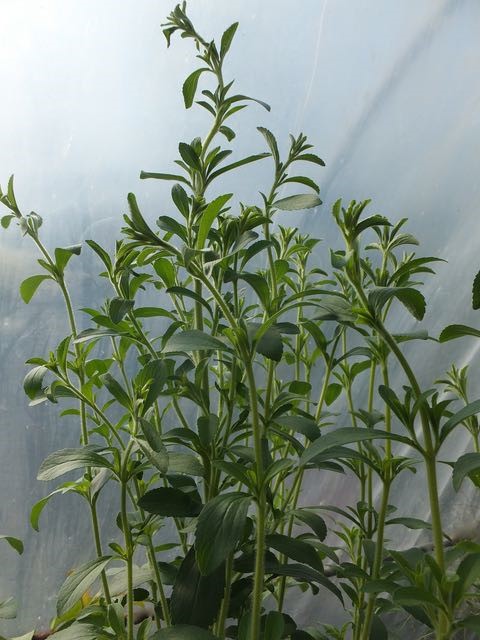
Stevia rebaudiana is a tender greenhouse herbaceous perennial that hardly stands out. A foot or two high with neat green leaves and small white flowers in summer (if not trimmed off) this is just a ‘nice looking’ plant. However growing this is right on trend as it’s one of the new ‘super food’ sweeteners. The leaves are incredibly sweet when chewed, reckoned 200 times sweeter than sugar but with negligible calories. (Actually you ought not chew them as the EU has bizarrely banned the leaves for human consumption even though the processed sweetener extracted is being added to foods, so you may only grow this as an ornamental.)
This is one of many members of this genus from the Asteracaea family discovered in South America and Mexico during the early 1800s and first introduced as greenhouse specimens. They became popular as autumn flowering bedding in Victorian gardens with three dozen species in cultivation blooming in purple, violet , white and pink. Most reached a height of only a foot or so and were tidy in growth. Stevias became less popular when the great gardens faded as they required a hothouse for propagation.
Given heat Stevia rebaudiana is easy to grow from seed, it’s not particular as to compost though dislikes wet claggy mixtures which cause rots and death. I use John Innes loam based seed compost with extra sharp sand for sure drainage then pot up later into their potting compost also with extra sand.
Stevia can also be multiplied with softwood cuttings in summer which is also easier with some bottom heat when they strike more quickly. Also, bushier plants can just be divided and repotted.
It does help to use warm rainwater when watering but this is not strictly essential. Be careful not to over-water and waterlog the plants but otherwise they’re relatively trouble free and don’t suffer much from pests or diseases. High fertility isn’t required and a light liquid feed monthly in summer will suffice.
This species hails from Brazil and Paraguay so requires some warmth to get going then needs to be frost free, it can be stood outside in a sunny corner for summer but is happier under glass.
Another species, Stevia serrata, once called Piqueria trinerva, can sometimes be found in florists shops where it‘s known simply as Stevia and much admired for cut flower arrangements with it’s small lightly fragrant white circular disc like flowers and clean green foliage.
By the way the genus was not named after someone called Steve but after Pedro Esteve a sixteenth century Spanish botanist from Valencia.










